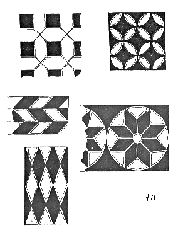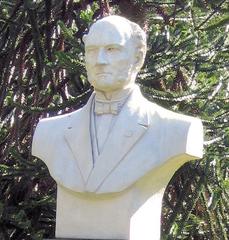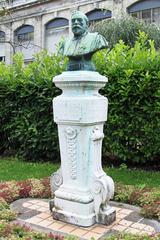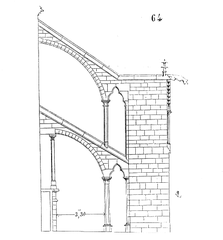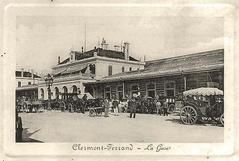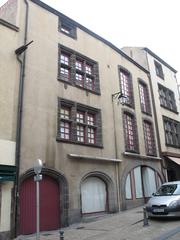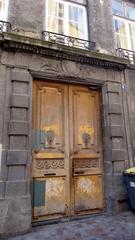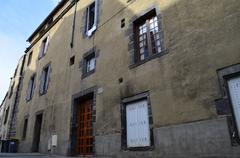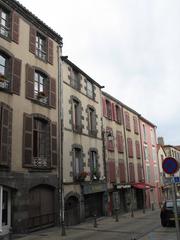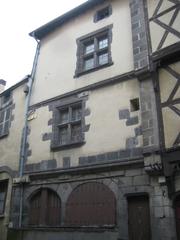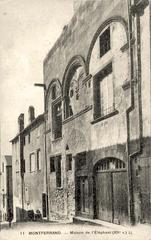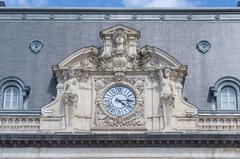Visiting Immeuble at 15 Rue Du Port, Clermont-Ferrand, France: Tickets, Hours, and Tips
Publication Date: 14/06/2025
Introduction
Nestled in Clermont-Ferrand’s historic Quartier du Port, 15 Rue du Port is an architectural landmark and a testament to the city’s layered urban and cultural heritage. This guide provides a comprehensive overview for visitors: from historical background and architectural highlights to practical information on tickets, accessibility, and nearby attractions. Whether you’re an architecture enthusiast, history buff, or a curious traveler, this article equips you with everything needed for an enriching visit to Rue du Port and its iconic Immeuble (France 3 Régions, Monumentum, Clermont-Ferrand Official Tourist Office).
Historical Evolution of Rue du Port
Rue du Port, one of Clermont-Ferrand’s most storied streets, dates back to the medieval era. Its name, “portus,” refers not to a harbor, but to a market area—a nexus for trade and social gatherings outside the city’s original walls. The street’s location made it a natural thoroughfare for merchants, dignitaries, and pilgrims, notably as the site where Pope Urban II called for the First Crusade in 1095 (France 3 Régions). Over time, Rue du Port became a principal entryway into the city, evolving into a showcase for architectural innovation and civic life.
Architectural Diversity and Notable Structures
Romanesque Heritage: Basilique Notre-Dame-du-Port
The Basilique Notre-Dame-du-Port is the street’s crowning jewel—a UNESCO World Heritage Site exemplifying Auvergnat Romanesque style. Built in the early 12th century, its pyramidal chevet, ornate stonework, and over 250 sculpted capitals make it a magnet for pilgrims and art historians (Lonely Planet).
Private Mansions (Hôtels Particuliers)
Rue du Port is renowned for its hôtels particuliers, or private mansions, built from the 14th to 19th centuries. Noteworthy examples include:
- Hôtel Montrosier de la Vilatelle (18th–19th c.): Classic courtyard and grand porte cochère.
- Hôtel de Ribeyre: Features a Louis XIII wooden door and medieval fortification elements.
These residences often hide richly decorated courtyards and portals behind discreet facades, charting the evolution of Clermont-Ferrand’s urban elite (France 3 Régions).
Art Deco and Modernist Influences: Immeuble at 15 Rue du Port
The Immeuble at 15 Rue du Port, built in 1933 by Ernest Pincot, is a striking example of Art Deco. Its stepped, overhanging facades, rounded corner, tall vertical windows, and geometric ceramic inlays define its style. The use of Volvic volcanic stone—a hallmark of Clermont-Ferrand—further roots it in local tradition. Inscribed as a Monument Historique in 2004, it symbolizes the city’s interwar modernism (Monumentum).
Vernacular and Commercial Architecture
The street also features vernacular buildings and shops with Art Nouveau elements, such as the “Boulangerie Moderne,” noted for its decorative facade and signage. Many ground-floor businesses retain original stonework and wooden storefronts, maintaining Rue du Port’s commercial vibrancy.
Cultural and Social Significance
Pilgrimage and Religious Life
Rue du Port’s proximity to the basilica has made it a focal point for religious processions and pilgrim hospitality. The street’s cosmopolitan atmosphere is a direct result of centuries of international travel and spiritual tradition (Clermont Auvergne Volcans).
Civic and Artistic Life
Traditionally a ceremonial entry to the city, Rue du Port welcomed dignitaries and hosted civic events. Today, it is a dynamic hub for artists and creatives, with workshops, studios, and seasonal public art installations (Clermont Auvergne Volcans).
Urban Fabric and Visitor Experience
Streetscape and Planning
Rue du Port retains its medieval alignment, gently curving and sloping through the city center. The pedestrian-friendly street, with irregular building alignments and varied rooflines, invites leisurely exploration (Clermont Auvergne Volcans).
Visitor Highlights
- Architectural Variety: Romanesque, Renaissance, Baroque, and Art Deco styles.
- Public Art: Seasonal bollard costumes and whimsical installations.
- Museums: The “Musée insolite du Port,” a private cabinet of curiosities (France 3 Régions).
Practical Information: Visiting Hours, Tickets & Tips
- Rue du Port: Public street, accessible year-round.
- Basilique Notre-Dame-du-Port: Open daily, 8:00 AM–7:00 PM (Trip.com).
- Entry Fees: Free for street and basilica; some special tours may charge.
- Guided Tours: “Parcours du Port” and other themed tours available via the Clermont-Ferrand Tourist Office (Clermont Auvergne Volcans).
- Accessibility: Pedestrianized, but historic paving may be uneven.
- Nearby Attractions: Place Delille, Clermont-Ferrand Cathedral, city markets, and museums.
15 Rue du Port: Hours, History, and Architectural Highlights
Historical Context
15 Rue du Port sits among a cluster of hôtels particuliers, reflecting periods of post-medieval urban renewal. While the building’s earliest history is not fully documented, its placement among neighboring mansions and its Renaissance-to-19th-century features suggest a rich lineage within Clermont-Ferrand’s elite social fabric.
Architectural Features
- Volvic Stone Facade: Robust, dark stonework, typical of Clermont-Ferrand.
- Decorative Elements: Stone-framed windows, wrought iron balconies, carved wooden doors.
- Interior: While generally not open to the public, similar mansions in the area feature spiral staircases, painted ceilings, and sculpted motifs.
Heritage Status
Protected as part of a historic urban ensemble, 15 Rue du Port is emblematic of the city’s evolution and ongoing conservation efforts.
Urban Integration & Access
Located near Place de la Victoire and the cathedral, 15 Rue du Port is accessible via tram (Place Delille stop) and several bus lines (Visorando). The main train station is a 30-minute walk.
Visiting 15 Rue du Port: Practical Details
- Access: The building itself is private; the street is public and open to visitors at all times.
- Special Events: Occasionally open during European Heritage Days (European Heritage Days in Clermont-Ferrand).
- Tickets: None required for exterior viewing; check local listings for special event access.
- Tours: Guided walking tours are available via the tourist office (Clermont-Ferrand Official Tourist Office).
- Best Time to Visit: Early mornings and late afternoons for optimal light; weekends for a relaxed pace.
- Visitor Tips: Wear comfortable shoes, respect private property, and use public transport for convenience.
Notable Neighbors
- 13 Rue du Port: 17th-century portal with cornucopia motifs.
- 21 Rue du Port: 15th-century door with gargoyle supports.
- Cité Vaudoit: Late 19th-century ensemble with unique tower and stained glass.
Nearby Historical Sites and Points of Interest
- Basilique Notre-Dame-du-Port: Free entry, open daily. UNESCO heritage and Romanesque art (France-Voyage).
- Clermont-Ferrand Cathedral: Free entry, tower access €5, panoramic city views.
- Fontaine d’Amboise: 16th-century fountain, open 24/7.
- Église Saint-Eutrope: Romanesque-Gothic church, free entry.
- Musée d’Histoire Naturelle Henri-Lecoq: Regional natural history, tickets €5.
- Musée Bargoin: Archaeology and textiles, tickets €6.
- FRAC Auvergne: Contemporary art, free entry (Visorando).
Amenities and Services
- Tourist Office: Place de la Victoire, under 500 meters away, offers maps and advice.
- Restrooms: Place de la Victoire and Place Delille.
- Dining/Shopping: Numerous cafes, bakeries, and boutiques on Rue du Port and surrounding streets.
Walking Tours and Themed Circuits
The “Le Port” self-guided walking circuit includes 15 Rue du Port, marked by medallions and informational plaques (Visorando). Printed and digital guides are available.
Events, Festivals, and Accessibility
Clermont-Ferrand’s annual events—such as the Festival Les Nuées Ardentes and summer open-air series “Contre-plongées”—enrich the cultural calendar. The historic center is pedestrian-friendly, though cobblestones may require extra care for wheelchair users.
Frequently Asked Questions (FAQ)
Is 15 Rue du Port open to the public?
No regular interior access; exterior can be viewed anytime. Special events may allow limited access.
Are guided tours available?
Yes, via the tourist office and as part of themed circuits.
What are the best times to visit?
Daylight hours for architecture; weekends for a relaxed atmosphere.
Is the area accessible for wheelchairs?
Mostly, but cobblestones and narrow sections may pose challenges.
Summary and Visitor Recommendations
15 Rue du Port offers a unique window into Clermont-Ferrand’s architectural and urban heritage. While interior access is generally not available, its Volvic stone facade, Art Deco features, and location amidst a historic district invite admiration. Combine your visit with nearby UNESCO-listed sites and vibrant public spaces for a full cultural experience (Monumentum, Clermont Auvergne Volcans, France 3 Régions, Visorando).
For up-to-date itineraries, maps, and audio guides, download the Audiala app. Consult the Clermont-Ferrand Tourism Office for the latest information.
Sources and Further Reading
- France 3 Régions
- Monumentum
- Clermont Auvergne Volcans
- Clermont-Ferrand Official Tourist Office
- Visorando
- Trip.com
- France-Voyage
- European Heritage Days in Clermont-Ferrand
- Mapcarta: 15 Rue du Port
- Mappy: Hôtel Reboul, 15 Rue du Port
